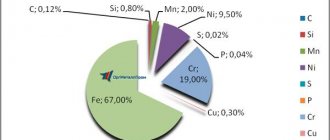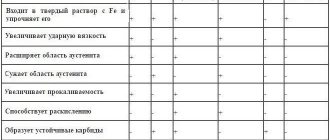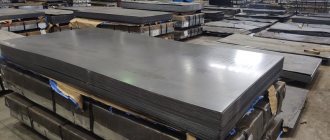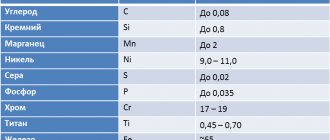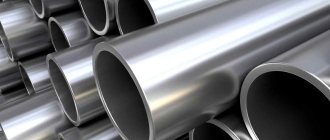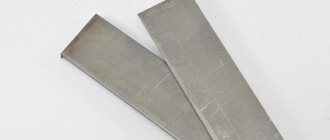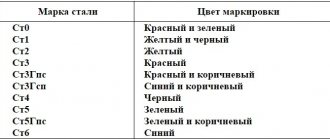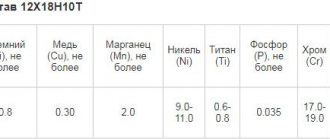General characteristics of corrosion-resistant steel
Corrosion-resistant steels include metal alloys that are highly resistant to corrosion processes in different atmospheric and climatic conditions, water, aggressive gas and chemical environments.
Anti-corrosion properties are ensured by enriching carbon steel with special elements, the most important of which is chromium. Its minimum content in the structure of alloys is 10.5%. Currently there are about 250 brands of stainless steel. The most used alloying elements are nickel, cobalt, titanium, molybdenum, niobium. Carbon, which is necessarily included in the composition, gives the finished products the necessary strength and hardness. Changing the proportions of chemical elements produces a metal with different properties, intended for specific areas of use.
Chemical composition of steels 08x18n10t and 12x18n10t
The differences in the chemical composition of the two steels being compared are, at first glance, insignificant. In terms of their chemical composition, both alloys belong to the class of stainless alloyed heat-resistant austenitic steels. Both steels are reinforced with such an important additive as titanium.
Their chemical composition differs only in the percentage of carbon content. In steel 08x18n10t it is up to 0.12%,
and in steel 12x18n10t - only
no more than 0.08%
. All other alloying elements are introduced into the alloys in equal quantities. However, this difference between 08x18n10t and 12x18n10t somewhat changes the properties of these steels, and, naturally, the scope of their application. Although in other respects, steels are interchangeable.
Full chemical composition of steels 08x18n10t and 12x18n10t
| Stamps | C | Si | Mn | P | S | Cr | Mo | Ni | V | Ti | Cu | W | Fe |
| 08x18n10t | <0,08 | <0,8 | <2,0 | <0,035 | <0,02 | 17,0–19,0 | <0,3 | 9,0-11,0 | <0,2 | <0,7 | <0,4 | <0,2 | Rest |
| 12x18n10t | <0,12 | <0,8 | <2,0 | <0,035 | <0,02 | 17,0–19,0 | <0,5 | 9,0-11,0 | <0,2 | <0,8 | <0,4 | <0,2 | Rest |
Characteristics of stainless steels and their areas of application
All types of stainless steel compounds can be divided into several groups. Each combines materials with specific chemical properties and internal structure.
- Austenitic (highly alloyed chromium-nickel metals, marking A)
- Ferritic (chromium, marking F)
- Martensitic (carbon, marking C)
- Combined
One of the most common and sought after types. The high content of nickel and chromium (up to 33%) provides exceptional corrosion resistance and unsurpassed strength to the products. An important advantage is manufacturability. The material welds well, is more viscous and plastic than ferrite, and is not magnetic. Austenitic grades include: 04Х18Н10, 12Х18Н10Т, 12Х18Н9Т, 12Х18Н9, 08Х18Н10, AISI 304, AISI 316, etc. The scope of their use is wide. Austenitic types of alloys are used as a structural material from which products are made by cold stamping and welding. These can be various containers, casing, pipelines, equipment for food processing and storage, pharmaceutical, medical, laboratory equipment, parts for the mechanical engineering, automotive, aircraft industries, technological units for the chemical industry.
Brands: 15Х28, 08Х18Т, etc. This group of metals has a high chromium content (up to 20%). It ensures product resistance to extremely aggressive chemical environments and high magnetic properties. Anti-corrosion resistance is lower than that of metals of the austenitic group, therefore ferritic types are used in those areas where the requirements for this parameter are not so significant. The main consumers of chromium ferritic steels are manufacturing enterprises in the chemical industry, heavy engineering, and the energy sector. They are used for the production of equipment and parts operating in acidic and alkaline solutions, household instrument making, and the food industry.
Grades: 20Х13, 40Х13, 30Х13, etc. Due to the high carbon content, these are the most durable alloys among stainless steel. Metal products of this group are extremely wear-resistant, work well at high temperatures, but are more susceptible to corrosion processes. This type of metal can be subject to thermal hardening; this type includes corrosion-resistant, heat-resistant steel, which successfully resists oxidation and is suitable for use at high temperatures. Metal products retain their original properties even under constant thermal influence; the material is characterized by a minimal content of harmful impurities.
Examples of grades: 08Х22Н6Т, 12Х21Н5Т, etc. Combined grades can have an austenitic-martensitic or austenitic-ferritic structure and organically combine the positive properties of alloys of these types.
How to identify food grade stainless steel at home
Analyzers and spectrometers are used to determine the chemical composition of steel. This is sophisticated equipment for professional use.
In order to determine whether metal can be used for storing and transporting food products at home, you can use “folk” methods:
- Using vinegar . To do this, you will have to stock up on a metal sample in advance, place it in 2% vinegar and wait for the reaction. If the surface has not darkened within a few hours, most likely the steel is actually food grade.
- By placing it in a working environment . A fragment of metal is placed in a liquid for storage or transportation of which steel or a product made from it is purchased. After a few hours, the results are assessed.
- Using sandpaper and copper sulfate . This method is suitable for those who are not sure about the metal from which stainless kitchen utensils are made. You should rub the pan with an abrasive material, then apply a solution of copper sulfate to the treated surface. If a red film appears, the steel is not suitable for contact with food.
There is a misconception among ordinary people that stainless steel can be determined by a magnet. Unfortunately, this method does not guarantee the correct choice, since among the stainless steels used for the manufacture of equipment for the food industry, there are steels that are magnetic and those that are not.
Most popular brands:
GOST 20Х13 (AISI 420, DIN 1.4021)
– stainless steel with a martensitic structure, cannot be welded, is not prone to temper brittleness, and does not form internal defects during the production process. Used for the manufacture of measuring and cutting tools, springs, leaf springs.
GOST 12Х17 (AISI 430, DIN 1.4016)
– ferritic stainless steel heat-resistant grade, does not contain nickel. Characterized by good anti-corrosion resistance in moderately aggressive chemical environments and high temperatures.
GOST 12Х18Н9 (AISI 304, DIN 1.4301)
– a heat-resistant, corrosion-resistant alloy used in welded structures in contact with aggressive environments. It is used for sheet parts, welded equipment, heat exchangers, pressure devices.
GOST 08Х18H10 (AISI 304H, DIN 1.4948)
– an austenitic type of heat-resistant, corrosion-resistant alloy, used for the production of rolled pipes, components and assemblies for the chemical and engineering industries, heat exchangers, and industrial tanks.
GOST 03Х18H11 (AISI 304L, DIN 1.4306)
– chromium-nickel grade is used for the production of equipment, tanks and pipelines for the chemical industry, in the production of nitric acid and other aggressive substances.
GOST 08Х18H10Т (AISI 321, DIN 1.4541)
– a stainless, heat-resistant and heat-resistant alloy, non-magnetic, resistant to oxidation and has good weldability without preheating. It is used as food and technical stainless steel for the production of rolled sheets and pipes, welded equipment, the manufacture of containers, tanks, tanks and equipment in the chemical and oil and gas industries.
GOST 03Х17H14М2, 03Х17H14М3, (AISI 316, 316S, 316L)
– non-hardening austenitic grade, areas of application – welded parts, equipment for the pulp and paper and chemical industries, boiler bodies, tanks and installations for the coal industry.
GOST 08Х17H13М2Т (AISI 316Ti, DIN 1.4571)
– structural heat-resistant heat-resistant stainless alloy is used for fasteners and welded structures in various industries.
GOST 20Х23H18 (AISI 310S, DIN 1.4845)
– heat-resistant and heat-resistant austenitic stainless steel used for the manufacture of forgings, clamps, combustion chambers, fasteners and boiler elements, used pipes, couplings.
When choosing stainless steel, you should take into account the operating conditions of the metal, the expected load, and the necessary additional properties of the product. If you are in doubt about how to choose the right stainless steel, it is better to contact a specialist. Leave a request on the website, and our managers will give recommendations on selecting the optimal grades of stainless alloys for the given operating conditions.
Classification of stainless steel grades
Depending on the composition of the alloy, the following groups of steels are distinguished:
- ferritic steels (also called chromium steels) contain more than 20% chromium and up to 0.15% carbon, due to which they have ductility, high resistance to highly aggressive environments and have good magnetic characteristics
- Austenitic (austenitic-ferritic and austenitic-martensitic) steels consist of up to 33% chromium and nickel
- martensitic and ferritic-martensitic contain up to 17% chromium and up to 0.5% carbon, have maximum resistance to various aggressive environments
Depending on the content of the alloying substance, certain alloys are used for various purposes and to work with various environments. Below is a list of steel grades that are most often used in the oil and gas and chemical industries.
| Steel marking | Steel type | Scope of application | Chemical composition |
| 12Х18Н10Т | austenitic chromium-nickel steels | for the manufacture of welded equipment in various industries | Cr 17-19 C up to 0.12 Si up to 0.8 Mn up to 2 Ni 9-11 S up to 0.02 P up to 0.0.5 Ti 5C-0.8 |
| 08Х18Н10Т | austenitic chromium-nickel steels | for the manufacture of welded products operating in environments of higher aggressiveness than steel grades 12Х18Н10Т and 12Х18Н9Т | Cr 17-19 C up to 0.08 Si up to 1 Mn up to 2 Ni 9-12 S up to 0.02 P up to 0.0.4 |
| 08Х18Г8Н2Т | chromium-manganese-nickel steels of the austenitic-ferritic class | for the manufacture of welded equipment operating in aggressive environments in the chemical, food and other industries | Cr 17-19 C up to 0.08 Si up to 0.8 Mn 7-9 Ni 1.8-2.8 S up to 0.025 P up to 0.0.35 Ti 0.2-0.5 |
| 08Х22Н6Т | chromium-nickel-molybdenum steels of the austenitic-ferritic class | for the manufacture of welded equipment in the chemical, food and other industries operating at temperatures not exceeding 300ºС | Cr 21-23 C up to 0.08 Si up to 0.8 Mn up to 0.8 Ni 5.3-6.3 S up to 0.025 P up to 0.0.35 Ti 5C-0.65 |
| 08Х18Н10 | austenitic chromium-nickel steels | for products subjected to heat treatment (hardening) | Cr 17-19 C up to 0.08 Si up to 0.8 Mn up to 2 Ni 9-11 S up to 0.02 P up to 0.0.04 Ti 5C-0.7 |
| 08Х17Н13М2, 08Х17Н13М2Т | chromium-nickel molybdenum steels of austenitic class | for technological equipment of the chemical industry | Cr 16-18 C up to 0.08 Si up to 0.8 Mn up to 2 Ni 12-14 S up to 0.02 P up to 0.035 Ti 5C-0.70 Mo 2-3 |
For reference Explanation of stainless steel grades: the name of the steel consists of alphabetic and numerical designations, in which the following are accepted: A (at the beginning of the grade) - sulfur, A (in the middle of the grade) - nitrogen, B - niobium, C - tungsten, D - manganese, D - copper, E - selenium, K - cobalt, M - molybdenum, H - nickel, P - phosphorus, P - boron, C - silicon, T - titanium, F - vanadium, X - chromium, C - zirconium, Yu - aluminum , Ch - REM (rare earth metals: lanthanum, praseodymium, cerium, etc.). The number after the letter indicates the average mass fraction of the alloying chemical element. The number before the letter indicates the mass fraction of carbon in hundredths. If the alloying element contains less than 1%, then the percentage is not indicated. For example: 12Х18Н10T is a stainless steel with a carbon content of 0.12%, 18% chromium, 10% nickel and less than 1% titanium.
Welding food grade stainless steel, possible options
The choice of welding method for stainless steel depends on the complexity of the product, the requirements for further operation, and the selected grade of steel. The most common method of welding stainless steel at home is classic electrode welding . You can choose the appropriate brand of electrodes for stainless steel on our website.
For seams that require higher quality, semi-automatic welding is used with stainless wire (MIG machines) or using filler rods (TIG machines) in a gas environment, for which argon or carbon dioxide is used.
If you are going to buy food grade stainless steel, contact the manager, we will select the appropriate steel for your purposes.
Technological properties of 12Х18Н10Т
Forging temperature
The initial temperature during hot processing should be about +1200 °C, and upon completion it drops to +850 °C. If the cross-section of stainless steel sheets does not exceed 350 mm, then cooling is carried out in air.
Flock sensitivity
Not sensitive.
Machinability
In the hardened state at HB 169 and B = 610 MPa: Ku tv. spl. = 0.85, Ku b. Art. = 0.35.
Weldability
Stainless steel has excellent weldability, so welding can be carried out without any special restrictions. After welding, it is recommended to perform heat treatment.
